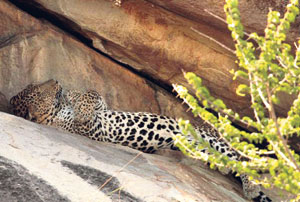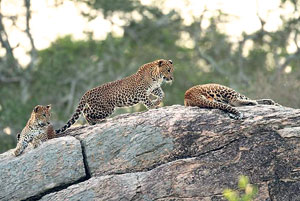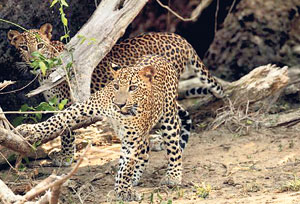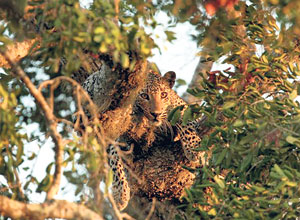Palitha Antony is a wildlife enthusiast and nothing brings him more satisfaction than a leopard sighting.
Just back from a three-night camping trip at the Jamburagala camp site at the Yala National Park, Palitha, his buddy Gehan Rajapakse and tracker Karunaratne had their fill this time- as many as 21 sightings.
 |
 |
| Rare sight: Adult male playing with cubs |
 |
| Who's there? Mother leopard emerging with a cub. |
 |
The first came at dawn when they got up the Jamburagala rock and spotted a healthy adult male leopard majestically walking along. As Palitha focused the camera and clicked, he noticed two cubs sprint up the rock and frolic with the male which was obviously the father of the cubs.
This was unusual as adult males even though they may be the fathers, do not take kindly to cubs. Meanwhile, at the bottom of the rock in the undergrowth was movement and their watchful eyes encountered an adult female and another little cub. For a moment the adult male and two cubs and the adult female and the third cub came together - the family. Quietly they parted company and the male went into the jungle by himself. Unfortunately the five together could not be photographed. Palitha with his wide experience in the jungles, says he has never seen anything like this before.
The Jamburagala camp site can comfortably accommodate four persons with camp beds on the concrete slab with a takaran (tin) roof, open to the jungle. As it is with the jungle, risks are inevitable. As the trio did their usual park round in the evening and got back at 6.3.0 pm. on the second day, they found their ice boxes(for storing food) strewn about and toppled and Gehan’s Blackberry phone smashed up in the bag. The culprit was getting away – a massive 11-foot male elephant. It was fortunate that they did not encounter it while they were in the camp.
But for Palitha and Gehan, such experiences are the norm. They ran the risk of the elephant returning at night while they slept. They were uneasy but as Palitha says “We have to encounter these dangers when we stay in the jungle. But we still do not mind because to be in the wild is such a beautiful experience.” That night they heard the sawing of a leopard quite close by which made them get up several times to make sure that the hurricane lamps went on burning till dawn broke. In the morning they saw a pair of leopards mating close to the camp site.
The many leopard sightings was the highlight of this trip for Palitha and Gehan who captured beautiful images. Among Palitha’s shots is one of a leopard, tummy up, sleeping peacefully on the Welmalkhema rock (see above). Khema is the vernacular term for a water hole in a rock. The Khema was just below where the big cat lay snoozing.
Palitha says that although the vehicular traffic within the Yala National Park has increased immensely, the animals, especially the leopards do not seem to mind the vehicles parked unobtrusively watching them and get on with their regular activities like the lions in the safari parks in Africa.
A sign that tourism had indeed hit a boom was evident says Palitha. “More than 90 percent of the vehicles were carrying foreign visitors.” But he was saddened by the unethical behaviour of some of the drivers of the hired jeeps from the Tissamaharama area. The three leopard cubs frolicked and played on the road with about six jeeploads of visitors watching quietly, parked one behind the other. Suddenly, a jeep came racing from the opposite direction (the driver obviously having been informed on his mobile phone) and drove straight at the cubs who ran away into the jungle, thus spoiling it for everybody else.
Perhaps the tourist hotels around the area should hold workshops for the jeep drivers to teach them jungle etiquette , where watching has to be done unobtrusively and with due respect to others as well.
As we spoke, Palitha was leaving to Wilpattu National Park, taking with him a massive Russel’s Viper caught in the army camp to be released to the wilds there by a snake expert who was travelling with him. |





